Searching for the Perfect Document Portal?
Need to streamline document collection and management? This listicle presents eight leading document portal software solutions to help your business, whether you’re a legal firm needing secure client document management, a real estate agency processing property paperwork, or an HR department handling employee onboarding. We’ll cover key features, pros, and cons of top options like Superdocu, SharePoint, Box, Confluence, Notion, Drupal, M-Files, and eFileCabinet, so you can choose the best document portal software for your needs.
Table of Contents
1. Superdocu
Superdocu stands out as a leading document portal software solution, offering a comprehensive platform for businesses to streamline their document collection, validation, and management processes. This cloud-based software empowers organizations to ditch tedious manual tasks and embrace automation, saving valuable time and resources. From customizable request links and branded portals to automated follow-ups and a centralized validation dashboard, Superdocu provides a robust toolkit for efficient and secure document handling. This makes it an excellent choice for businesses across various sectors, including legal, real estate, HR, immigration, transportation, and financial services.
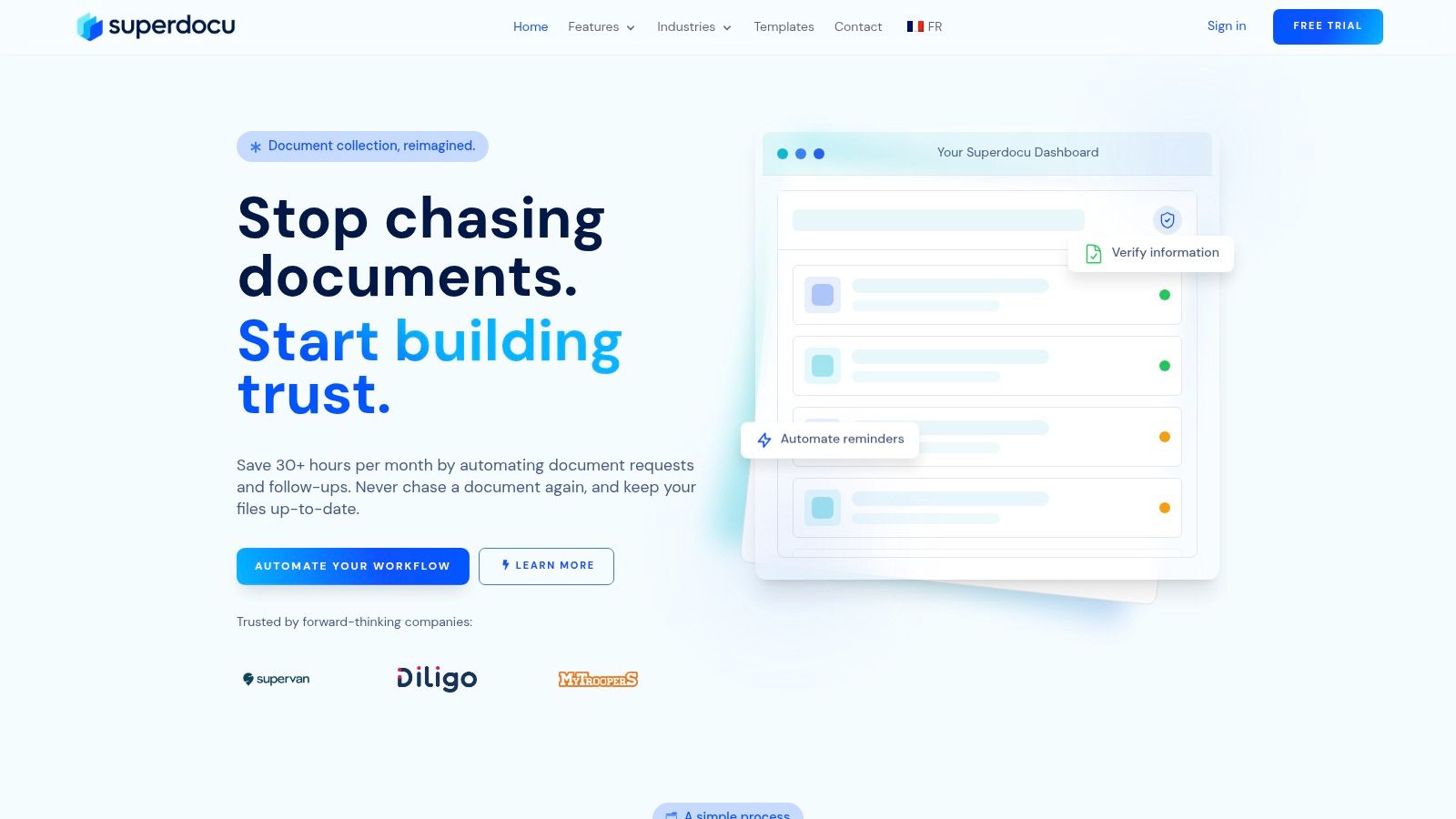
One of Superdocu’s key strengths lies in its automation capabilities. Imagine spending hours each week chasing down missing documents, sending reminder emails, and manually verifying information. Superdocu eliminates this administrative burden by automating document requests, follow-ups, and even validation processes, freeing up your team to focus on higher-value tasks. The platform boasts time savings of over 30 hours per month, which translates to increased productivity and significant cost reductions. Learn more about Superdocu’s capabilities regarding automated document collection from their blog post on document collection software.
Furthermore, Superdocu recognizes that different industries have unique document management needs. To address this, they offer tailored templates for various sectors, including legal, real estate, HR, immigration, and transportation. These templates provide a pre-built framework that accelerates deployment and ensures compliance with industry-specific regulations. For example, a law firm can utilize templates designed for client intake forms, while a real estate agency can leverage templates for lease agreements and property disclosures. This customization extends to workflows, allowing businesses to create automated processes tailored to their specific requirements.
Security is paramount when dealing with sensitive documents. Superdocu addresses this with enterprise-grade security features, including GDPR compliance, encrypted data storage, and European hosting. This robust security infrastructure provides peace of mind, assuring businesses that their confidential information is protected. The platform also integrates seamlessly with DocuSign, enabling businesses to incorporate eSignatures into their workflows, further streamlining document signing processes.
Beyond document collection and security, Superdocu prioritizes the client experience. Branded, white-label portals and emails enhance client interactions and reinforce corporate identity. Clients can securely submit documents from any device, enhancing accessibility and convenience. The intuitive interface simplifies the submission process, reducing friction and improving client satisfaction. On the administrative side, the validation dashboard provides a centralized view of all submitted documents, simplifying approval workflows and tracking document expirations with automated notifications.
Superdocu offers flexible pricing plans starting at €97/month with a 7-day free trial, catering to businesses of all sizes, from startups to large enterprises. However, this pricing structure might be a consideration for very small businesses or sole proprietors. While the basic plan offers a comprehensive set of features, some advanced functionalities, such as custom API access and automated document validation, are reserved for the Enterprise plan. Technical requirements are minimal, as the software is cloud-based and accessible through any modern web browser.
In comparison to other document portal software solutions, Superdocu distinguishes itself with its industry-specific templates, robust automation capabilities, and focus on client experience. While some competitors might offer lower entry-level pricing, Superdocu’s comprehensive features and focus on security justify the investment for businesses seeking a truly efficient and secure document management solution. Implementing Superdocu is straightforward. The intuitive interface allows for quick setup and customization, and the availability of pre-built templates minimizes configuration time. For businesses seeking a powerful and user-friendly document portal software, Superdocu offers a compelling solution that streamlines workflows, enhances security, and builds client trust. You can visit the website here to learn more.
2. SharePoint
Microsoft SharePoint is a powerful and versatile document portal software solution ideal for businesses of all sizes looking to streamline document management, improve collaboration, and enhance security. It provides a centralized platform for organizing, sharing, and accessing documents, enabling teams to work together more effectively. This robust platform offers advanced content management capabilities, making it a strong contender for organizations seeking a comprehensive solution for their document portal needs. SharePoint goes beyond basic file storage and allows you to create structured portals with metadata, workflows, and customized access permissions, turning a chaotic collection of files into a well-organized and easily searchable knowledge base.
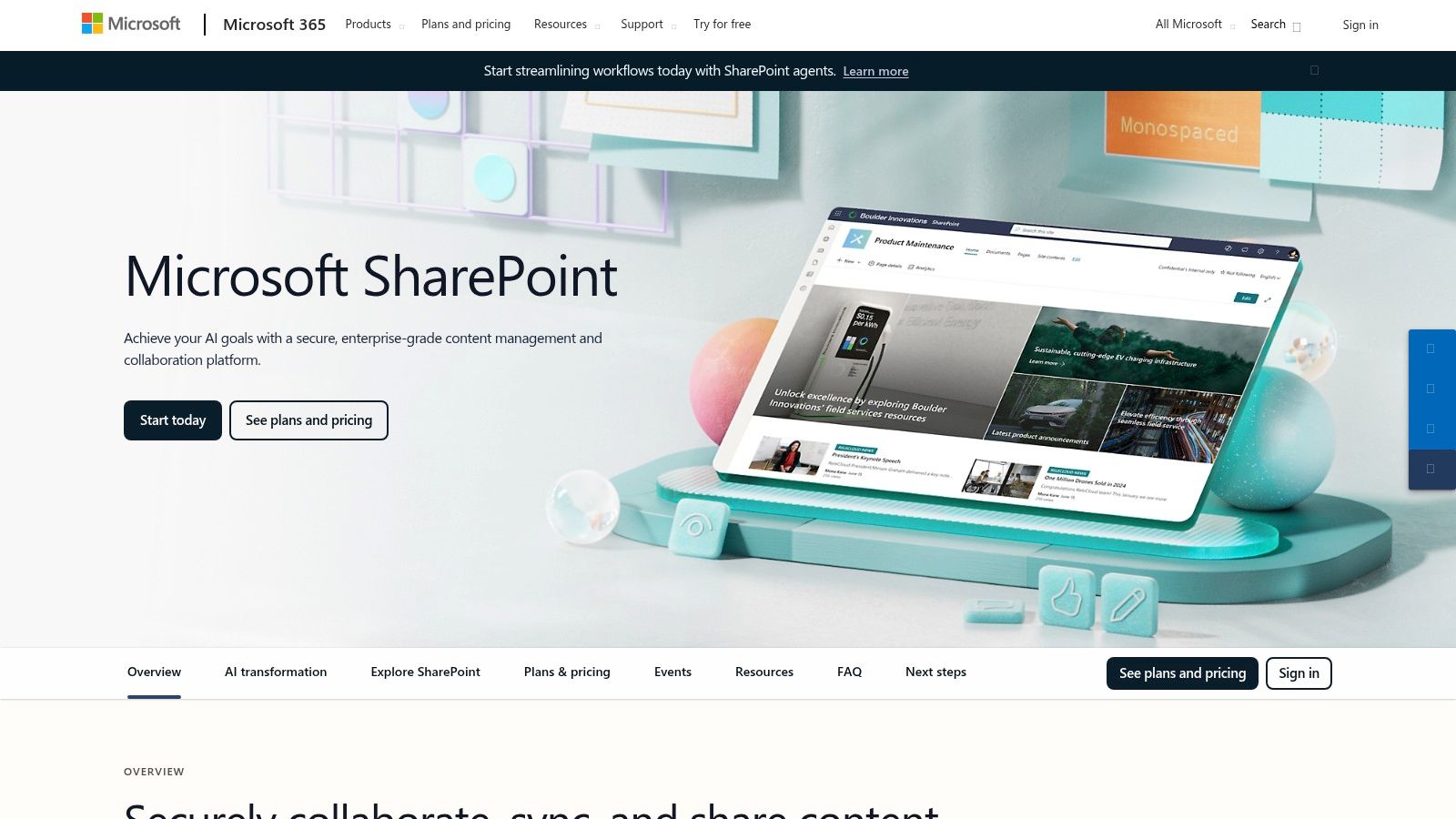
SharePoint’s adaptability makes it a compelling choice for a wide range of industries and use cases. For instance, legal firms can leverage SharePoint to create secure client portals for sharing sensitive documents while ensuring compliance. HR and staffing agencies can streamline onboarding processes by centralizing candidate documents and automating verification workflows. Real estate agencies can manage property documents and tenant applications efficiently, while mortgage brokers and financial services professionals can automate loan paperwork and ensure secure access for clients. Even transportation companies can benefit from SharePoint by collecting driver and vehicle documents, streamlining onboarding, and ensuring compliance. Immigration firms can easily manage the complexities of visa applications with organized client portals and automated workflows. Portfolio managers can use SharePoint as a secure repository for investment documents and client communications.
One of SharePoint’s key strengths lies in its seamless integration with the Microsoft 365 ecosystem. This allows for smooth interaction with familiar tools like Teams, Outlook, and Office applications, increasing productivity and minimizing the need for context switching. Imagine drafting a proposal in Word, collaborating on it in Teams, and then seamlessly storing the final version in your SharePoint document portal, all within a unified environment. This integration extends to robust workflow automation capabilities, allowing businesses to automate document approval processes, track changes, and manage versions effectively. You can even automate document routing for approvals, ensuring timely processing and reducing bottlenecks. If you’re looking to streamline and automate your document workflows, learn more about SharePoint.
SharePoint also shines in its security features. With granular permission controls, businesses can ensure that sensitive information is only accessible to authorized personnel. This is particularly crucial for industries dealing with confidential data, such as legal, finance, and healthcare. The platform offers enterprise-grade security features, including encryption, data loss prevention, and multi-factor authentication, providing peace of mind knowing your documents are safe and secure.
While SharePoint offers numerous benefits, it’s essential to be aware of its potential drawbacks. Implementing and managing SharePoint can require technical expertise, particularly for advanced customization and configuration. The learning curve for administrators can be steep, and smaller organizations might find the licensing costs challenging. Additionally, performance can sometimes be an issue with large document volumes or complex configurations.
SharePoint’s pricing is tiered, based on the features and storage required. Specific pricing details are available on the Microsoft website. The technical requirements vary depending on the deployment model (on-premises, cloud-based, or hybrid), but generally require a compatible server environment and client software for on-premises deployments, while cloud-based deployments are accessible through a web browser.
For smaller businesses or those seeking simpler document portal solutions, alternatives like Google Workspace or Dropbox might be worth considering. However, for organizations needing robust features, deep integration with the Microsoft ecosystem, and enterprise-grade security, SharePoint remains a leading contender in the document portal software landscape.
For implementing SharePoint successfully, start with a clear understanding of your document management needs and plan your information architecture accordingly. Begin with a pilot project focusing on a specific department or team to gain experience and refine your approach before rolling it out company-wide. Investing in training for your administrators and users will significantly improve adoption and maximize the platform’s potential. Finally, consider leveraging SharePoint’s extensive customization options to tailor the platform to your specific business processes and workflows. You can customize the look and feel, create custom document libraries, and even develop custom web parts to extend the platform’s functionality. By carefully planning your implementation and taking advantage of the platform’s extensive capabilities, SharePoint can become a powerful asset for your organization. Learn more on their website.
3. Box
Box stands out as a robust document portal software solution, particularly suited for businesses prioritizing security and streamlined collaboration. It goes beyond basic file sharing by offering a comprehensive platform for content management, making it ideal for creating secure document portals for both internal and external stakeholders. This makes it a strong contender for businesses dealing with sensitive information and requiring stringent access controls.

Box’s strength lies in its enterprise-grade security features. These include robust access controls, granular permissions settings, watermarking, and data loss prevention (DLP) capabilities. This makes it an excellent choice for industries with strict compliance requirements, such as legal firms managing client documents, financial services professionals handling loan paperwork, or healthcare providers dealing with patient records. Imagine a legal firm needing to securely share sensitive case files with clients. Box allows them to create a dedicated client portal with restricted access, ensuring only authorized individuals can view and interact with specific documents.
Furthermore, Box excels in external collaboration. Its guest access controls allow businesses to seamlessly collaborate with external parties like clients, vendors, or partners while maintaining control over data access. For example, a real estate agency could use Box to create a portal for prospective tenants, allowing them to securely upload application documents like proof of income and identification. This simplifies the application process and ensures sensitive information is handled securely. Similarly, mortgage brokers can leverage Box to create portals for clients, streamlining the document collection process for loan applications and reducing processing time.
Beyond secure sharing, Box offers workflow automation and approval processes. This feature can significantly improve efficiency in document-heavy workflows. For instance, HR and staffing agencies can use Box to automate the onboarding process, with new hires uploading required documents through a dedicated portal and automated approvals routing documents to the necessary stakeholders.
While Box provides a user-friendly interface suitable for non-technical users, its comprehensive API allows for deeper integration with over 1,500 business applications. This makes it a highly adaptable solution for businesses with complex IT infrastructures. A transportation company, for example, could integrate Box with their existing HR and fleet management systems, automatically collecting and organizing driver and vehicle documents within a central repository.
Box offers a tiered pricing structure, with plans tailored to different business needs. While the higher-tier plans unlock the full potential of its advanced features like custom branding and unlimited storage, smaller businesses may find the storage limitations on lower-tier plans restrictive. It’s crucial to carefully assess your storage needs and required features when selecting a plan. Specific pricing details are available on the Box website. It’s worth noting that Box’s pricing is generally higher than basic file sharing solutions, reflecting its focus on enterprise-grade features and security.
When compared to similar document portal software like ShareFile or Egnyte, Box differentiates itself through its robust security features and extensive integrations. ShareFile might be a better option for businesses prioritizing e-signatures and simpler file sharing, while Egnyte focuses on hybrid cloud solutions.
Setting up a document portal on Box is relatively straightforward. The intuitive interface allows for easy folder creation, user permission management, and branding customization. Box also offers extensive documentation and support resources to guide users through the setup process.
In conclusion, Box is a powerful document portal software solution that prioritizes security, collaboration, and integration. While it might not be the cheapest option, its robust features and user-friendly interface make it an excellent choice for businesses needing a secure and efficient way to manage and share documents with internal and external stakeholders. For organizations dealing with sensitive information and complex workflows, Box’s comprehensive capabilities justify its position as a leading document portal solution. You can explore Box’s features and pricing in detail on their website: https://www.box.com/.
4. Confluence
Atlassian Confluence stands out as a versatile team workspace platform, particularly adept at creating robust knowledge bases and document portals. Its unique blend of wiki-style content creation and powerful collaboration features makes it an ideal solution for various document management needs, including internal documentation portals, project wikis, and team knowledge sharing. Confluence empowers teams to centralize information, streamline workflows, and foster a collaborative environment. This makes it a strong contender for businesses looking for comprehensive document portal software.
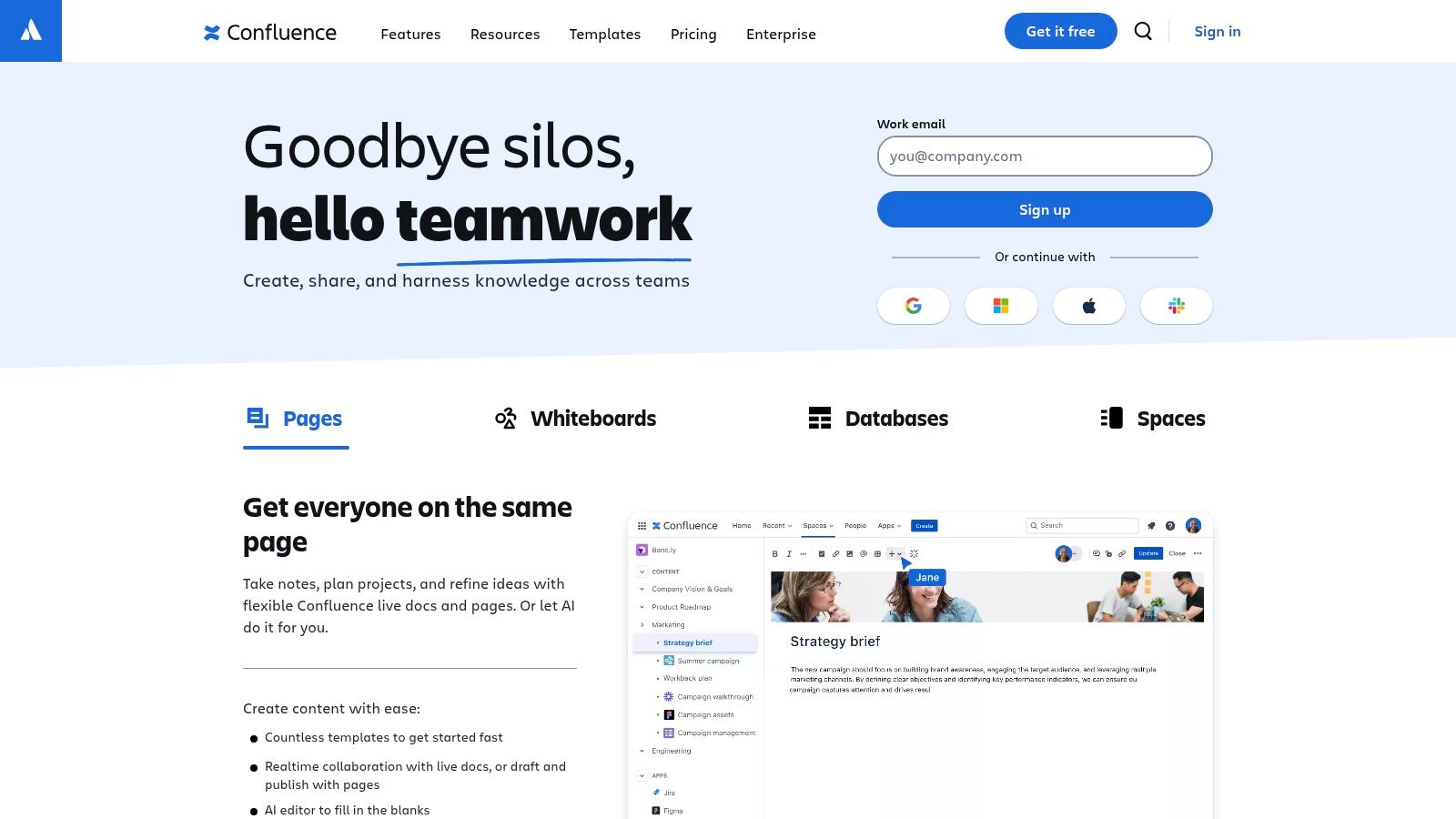
Confluence’s strength lies in its flexible and adaptable nature. Its space-based organization allows for a hierarchical page structure, creating a logical and easily navigable repository for all types of documents. Imagine a legal firm using Confluence: each client could have their own dedicated space, with sub-pages for different case files, contracts, and communications. This structure helps maintain organization even with a high volume of sensitive client data. Similarly, HR departments can leverage Confluence for employee onboarding, creating spaces for each new hire with checklists, training materials, and policy documents. Real estate agencies could organize property listings, tenant applications, and legal documents within dedicated spaces, ensuring easy access and streamlined processes.
The platform shines with its real-time collaborative editing and commenting features. Multiple team members can work on the same document simultaneously, fostering a collaborative environment and accelerating project completion. For example, a mortgage broker could use Confluence to collaborate with clients on loan applications, with both parties able to review and update the document in real time. This eliminates the need for back-and-forth email exchanges and ensures everyone is working with the most up-to-date information. The built-in rich text editor allows for easy formatting and embedding of multimedia content, enhancing the clarity and comprehensiveness of documents.
One of Confluence’s major advantages is its seamless integration with other Atlassian tools, including Jira, Trello, and Bitbucket. This is particularly beneficial for software development teams, allowing them to link project documentation directly to tasks, bug reports, and code repositories. This level of integration streamlines workflows and provides a holistic view of project progress. Imagine a development team using Jira for project management and Confluence for documentation. They could link specific Jira tasks to relevant Confluence pages, allowing team members to easily access the necessary documentation while working on their assigned tasks.
Confluence offers a range of customization options through templates and macros, ensuring that the platform can be tailored to meet the specific needs of different teams and industries. Pre-built templates for meeting notes, project plans, and product requirements can save significant time and effort, while custom macros allow for automated formatting and content insertion. The active marketplace offers a wide range of add-ons, further extending the platform’s functionality.
However, Confluence is not without its drawbacks. Managing a large volume of content can become challenging, and while the search functionality is robust, careful planning and organization are crucial to prevent information overload. The platform’s document version control, while adequate for general use, is less comprehensive than dedicated Document Management Systems (DMS). This could be a consideration for industries with strict compliance requirements, such as legal or financial services.
Pricing for Confluence is based on the number of users, which can become expensive for larger teams. Finally, while the basic features are relatively easy to grasp, mastering the advanced features and customization options requires a learning curve.
Pricing: Confluence offers a free plan for small teams (up to 10 users) with limited features. Paid plans start at $5.75 per user per month for small teams and scale up based on the number of users and features required.
Technical Requirements: Confluence is available as a cloud-based service or can be self-hosted. The cloud version requires no specific technical infrastructure, while self-hosting requires a server environment that meets Atlassian’s specifications.
Despite these limitations, Confluence’s powerful combination of wiki-style content creation, collaboration tools, and integration with the Atlassian suite makes it a valuable asset for businesses looking to centralize their documentation and streamline workflows. For those seeking a flexible and feature-rich document portal solution, Confluence is certainly worth considering. Visit their website (https://www.atlassian.com/software/confluence) for more information.
5. Notion
Notion has rapidly gained popularity as a versatile workspace solution, and its flexible architecture makes it a strong contender for document portal software. While not explicitly designed solely as a document portal, its adaptable features allow businesses to create highly functional and customized portals for managing internal knowledge bases, client documentation, project files, and more. This makes it particularly appealing to smaller and medium-sized businesses seeking a cost-effective yet powerful solution. It’s also a great option for teams who already utilize Notion for other purposes, creating a centralized hub for all work processes.
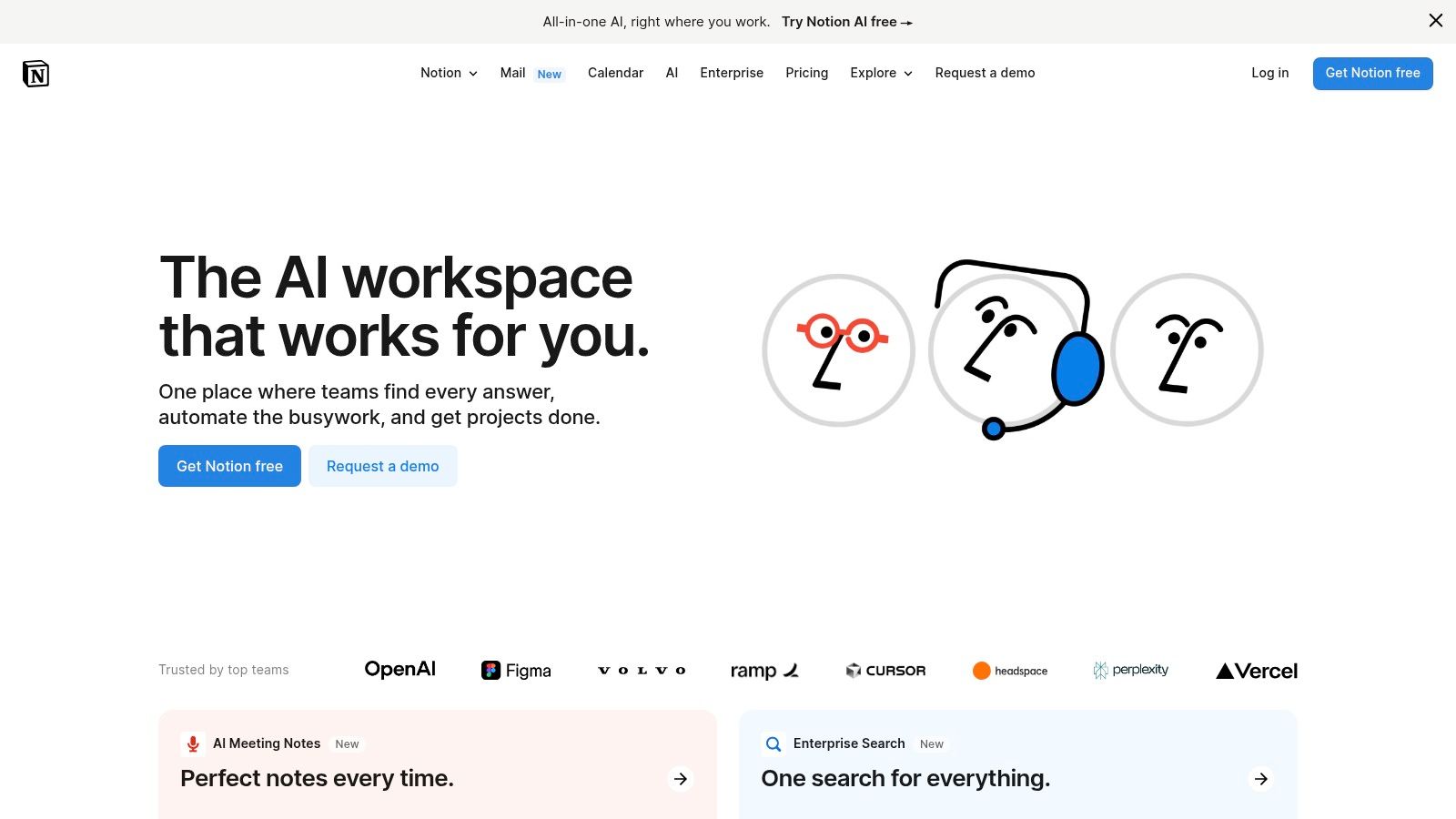
Notion’s strength lies in its block-based editor. This allows users to seamlessly combine different content types – text, images, videos, databases, checklists, and even embedded web pages – within a single document. This flexibility is key to building a comprehensive and interactive document portal. For example, a legal firm could create a client portal with contact information, case details, relevant documents, and a communication log, all within one Notion page. Similarly, HR departments can use Notion to onboard new employees, providing access to company policies, training materials, and onboarding checklists in an organized and accessible manner.
The database functionality is another critical component for building effective document portals. Notion allows you to create databases to categorize and tag documents, making it easy to search and filter information. For example, a real estate agency could use a database to organize property listings, including photos, descriptions, legal documents, and client information. This structured approach significantly improves document retrieval and overall efficiency. Mortgage brokers can similarly benefit by creating databases for loan applications, tracking progress and required documentation for each client.
Notion’s real-time collaboration features further enhance its utility as document portal software. Multiple users can simultaneously access and edit documents, fostering teamwork and streamlining workflows. The built-in commenting system facilitates communication and feedback, ensuring everyone stays on the same page. This is particularly beneficial for project teams, legal teams collaborating on cases, or transportation companies managing driver documentation and onboarding processes. Immigration firms can use this collaborative feature to efficiently manage visa application documents and communicate with clients regarding their case status.
Pricing and Technical Requirements: Notion offers a generous free plan suitable for individual users and small teams. Paid plans, which unlock additional features like increased file uploads and team collaboration, start at a reasonable price point, making it an attractive option for budget-conscious businesses. Notion is a cloud-based platform accessible through web browsers and dedicated desktop and mobile apps, ensuring cross-platform compatibility and offline access.
Comparison and Implementation Tips: Compared to dedicated enterprise document management systems, Notion might lack advanced security features and granular permission controls. However, its flexibility, ease of use, and affordability make it a strong competitor, particularly for smaller businesses and teams. When setting up a document portal in Notion, start by clearly defining your requirements and document categories. Utilize templates from the Notion gallery or create your own to ensure consistency and structure. Establish a clear naming convention and tagging system to facilitate efficient search and retrieval. Leverage the database features to categorize and organize your documents effectively.
Pros:
- Highly flexible and customizable interface: Tailor the portal to your specific needs.
- Cost-effective pricing with a generous free tier: Accessible for businesses of all sizes.
- Intuitive user experience with a minimal learning curve: Easy to adopt and implement.
- Strong community and template ecosystem: Leverage pre-built templates and resources.
Cons:
- Limited enterprise-grade security features: Might not be suitable for highly sensitive data.
- Performance issues with very large databases: Scalability can be a concern for large organizations.
- Basic permission controls compared to enterprise solutions: Less granular control over access rights.
- Limited integration options with business systems: May require workarounds for seamless integration with existing workflows.
Website: https://www.notion.so/
Notion’s adaptable nature and ease of use make it a compelling choice for businesses looking to implement a user-friendly and cost-effective document portal. While it may not be a full-fledged enterprise document management system, its flexibility and rich features make it a valuable tool for organizing and managing information, ultimately boosting productivity and collaboration. Its affordability and intuitive interface make it a particularly attractive option for small to medium-sized businesses, portfolio managers, and various agencies requiring streamlined document management.
6. Drupal
Drupal stands out as a powerful and highly flexible open-source content management system (CMS) that can be leveraged to build robust and customized document portal software. Unlike out-of-the-box solutions, Drupal provides a foundation upon which you can construct a portal tailored precisely to your organization’s specific document management needs. This makes it particularly attractive to businesses requiring complex workflows and unique functionalities not typically found in pre-built software. While it requires more technical expertise to implement than some other solutions, its flexibility and scalability make it a compelling option for organizations looking for long-term growth and adaptability.
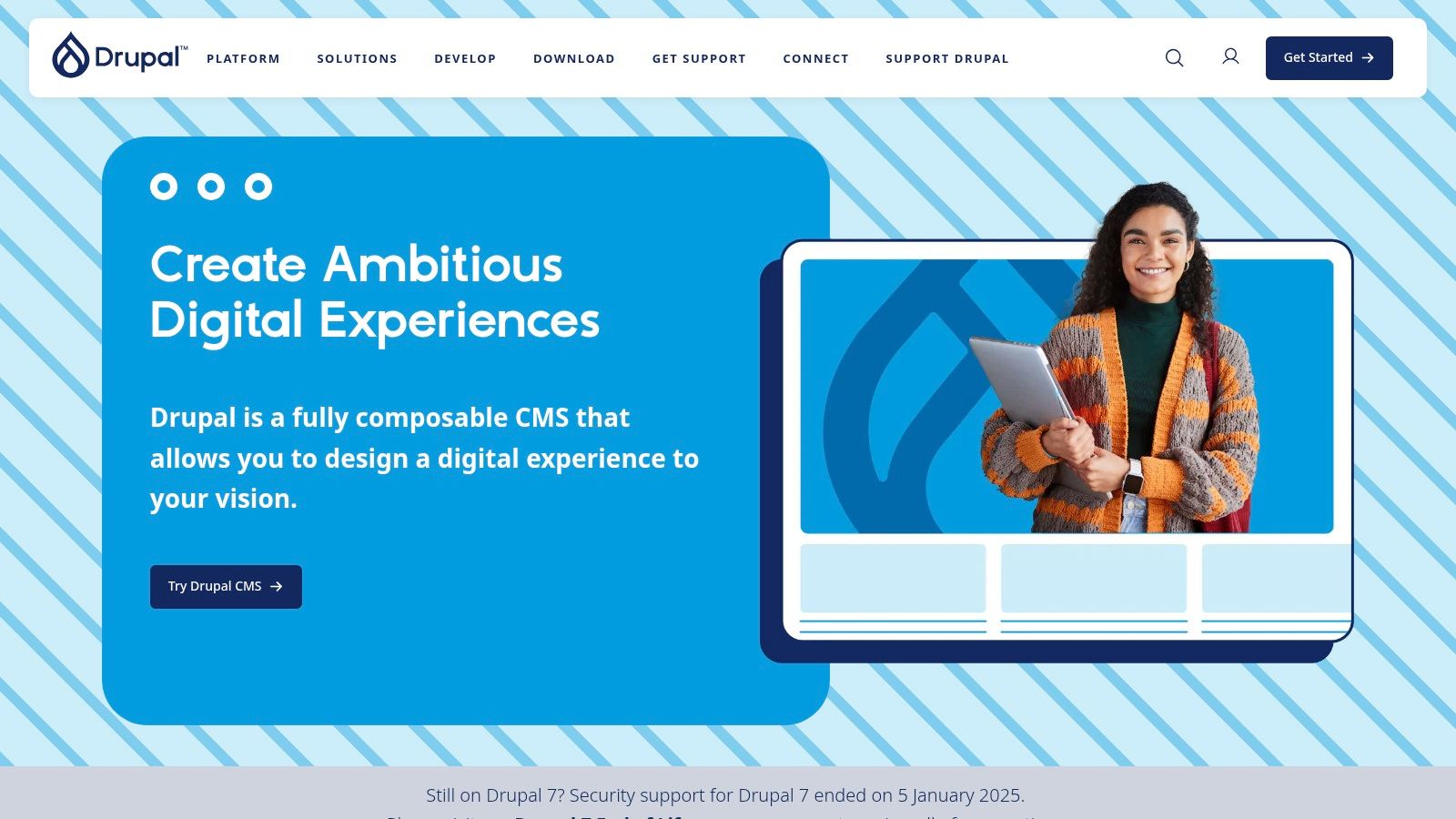
Drupal’s modular architecture is its core strength. With thousands of available modules, you can add functionalities like advanced search, version control, digital signature integration, and much more. This allows you to create a document portal that perfectly aligns with your workflows, whether you’re a legal firm managing sensitive client documents, a real estate agency processing property paperwork, or a mortgage broker automating loan applications.
For example, a legal firm could leverage Drupal to build a secure client portal where clients can upload documents, track case progress, and communicate securely with their lawyers. The firm can configure custom content types for different case types, manage access permissions granularly, and automate document workflows to ensure compliance. Similarly, a transportation company can use Drupal to build a driver onboarding portal, collecting necessary documents like licenses, medical certificates, and background checks, all while managing access and approvals within a streamlined system.
Drupal’s advanced user role and permission management features are essential for organizations dealing with sensitive data. You can define specific roles with varying access levels, ensuring that only authorized personnel can view, edit, or approve documents. This granular control is critical for maintaining compliance with industry regulations and safeguarding confidential information. This is especially valuable for industries like healthcare, finance, and legal, where data security is paramount.
While the core Drupal software is free and open-source, the overall cost depends on several factors. Development and implementation require technical expertise, meaning you’ll likely need to hire Drupal developers or engage a specialized agency. This can be a significant investment upfront. Ongoing maintenance, hosting, and infrastructure management also contribute to the total cost of ownership. However, the absence of licensing fees for the core platform can offset some of these expenses, particularly for larger implementations.
Key Features of Drupal for Document Portals:
- Modular Architecture: Extend functionality with thousands of modules.
- Advanced User Roles and Permissions: Granular control over document access.
- Custom Content Types and Fields: Tailor the portal to specific document types.
- Multi-site Management: Manage multiple portals from a single platform.
- Workflow and Content Approval Systems: Streamline document review and approval processes.
Pros:
- Completely Customizable: Build a portal that fits your exact needs.
- Strong Security: A proven track record and regular security updates.
- Scalable: Handles large volumes of documents and users effectively.
- No Licensing Costs: Free and open-source core platform.
Cons:
- Requires Technical Expertise: Implementation and customization require developers.
- Higher Development Costs: Initial investment can be significant.
- Steep Learning Curve: Content editors may require training.
- Requires Hosting and Infrastructure: Ongoing costs for hosting and maintenance.
Implementation Tips:
- Plan carefully: Clearly define your requirements and document workflows before starting development.
- Engage experienced Drupal developers: Ensure they have experience building document portals.
- Start with a minimal viable product (MVP): Focus on core features initially and add more functionality iteratively.
- Test thoroughly: Rigorous testing is crucial before launching your portal.
Drupal offers unparalleled customization for document portal software. While it requires a greater technical investment compared to simpler solutions, the flexibility and scalability it provides make it a compelling option for organizations with complex document management needs. If you’re seeking a document portal that can evolve with your business and adapt to future requirements, Drupal is worth serious consideration. You can learn more at https://www.drupal.org/.
7. M-Files: Intelligent Document Portal Software for Streamlined Operations
M-Files stands out as a powerful document portal software solution that leverages a metadata-driven architecture. This means it moves beyond simply storing files and focuses on understanding what they are. By automatically organizing and managing documents based on their content and context, M-Files transforms chaotic file systems into easily navigable, searchable portals. This makes it a particularly good fit for businesses dealing with large volumes of information or those in regulated industries requiring strict document control, such as legal, financial services, and healthcare. This intelligent approach to document management makes it a valuable tool for streamlined operations. Instead of searching through folders, users can quickly find documents based on what they are, such as “contracts,” “invoices,” or “client files,” regardless of where they’re stored.
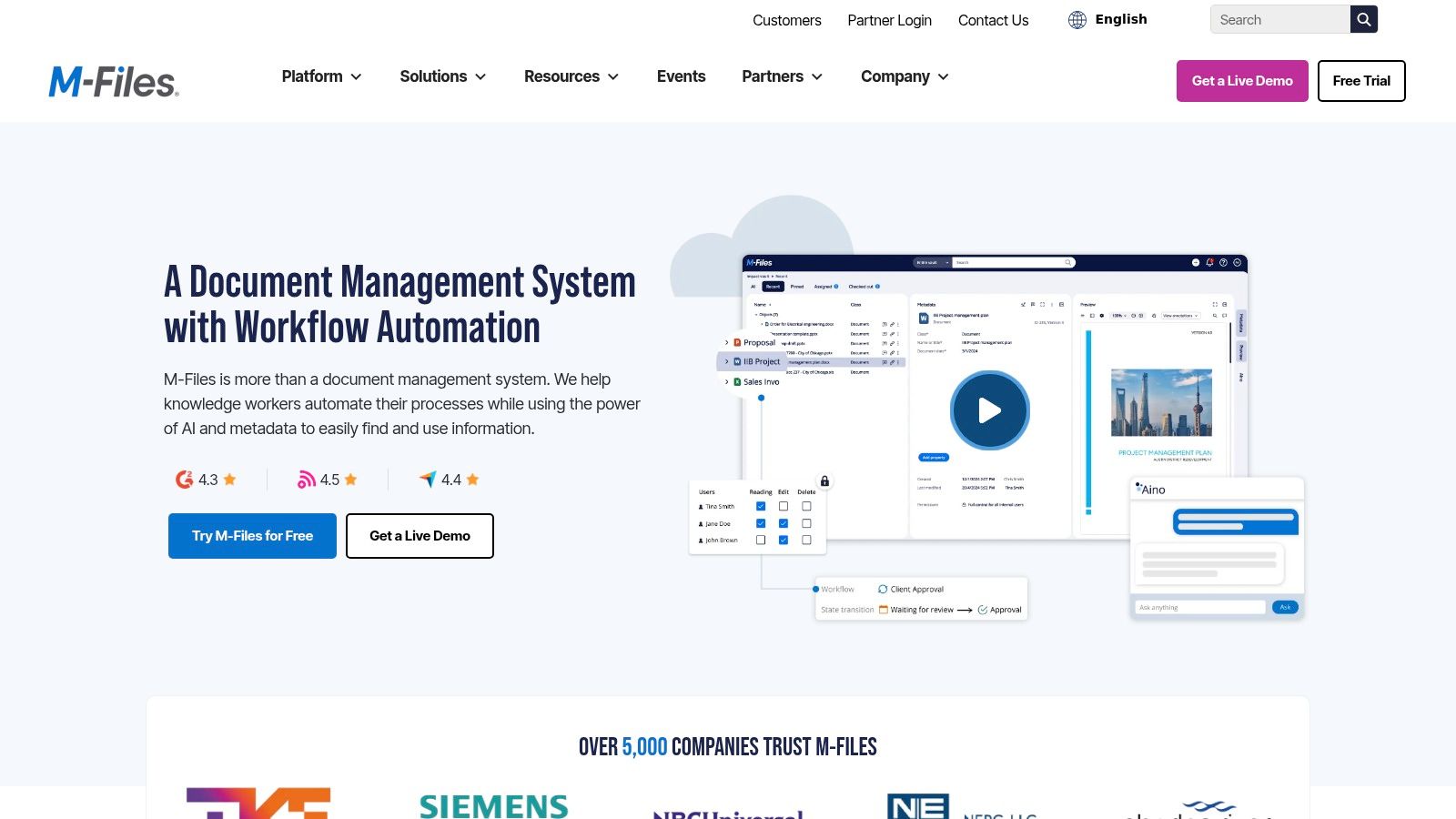
Think of M-Files as a sophisticated librarian for your digital documents. Its AI-powered content classification engine automatically tags and categorizes documents, minimizing manual data entry and significantly reducing the time spent searching for information. Imagine a real estate agency using M-Files: tenant applications, property documents, and lease agreements are automatically tagged and categorized, making them instantly accessible to agents. Similarly, a legal firm can manage client files, contracts, and case documents with enhanced security and compliance.
M-Files offers a rich set of features tailored for creating robust document portals. Advanced workflow automation capabilities allow you to define approval processes, routing documents to the right people at the right time. This is incredibly beneficial for tasks like contract approvals or onboarding new employees. For instance, HR and staffing agencies can use M-Files to automate candidate onboarding, ensuring all necessary documents are collected, verified, and approved efficiently. Learn more about M-Files and its applications for document collection. This streamlined process frees up HR staff to focus on other critical tasks.
Furthermore, M-Files excels in its compliance and audit trail capabilities. This makes it particularly attractive to industries like financial services and healthcare, where maintaining a comprehensive record of document access and modifications is crucial. Mortgage brokers, for instance, can utilize M-Files to manage loan paperwork, ensuring compliance with regulatory requirements and providing a clear audit trail for each loan application. The system tracks every document interaction, providing a complete history for audits and investigations.
Another significant advantage of M-Files is its ability to integrate seamlessly with existing business systems and file structures. This means you don’t have to overhaul your entire IT infrastructure to implement it. It can connect with your CRM, ERP, and other core systems, creating a centralized repository for all your business-critical documents. For transportation companies, this integration could mean connecting M-Files to their driver management system, streamlining the collection and management of driver and vehicle documents.
While M-Files offers a powerful solution for document portal software, it’s important to consider its potential drawbacks. Compared to more basic document management systems, M-Files comes at a higher cost. The platform’s complexity also means the initial setup and configuration can be challenging, often requiring specialized expertise. While M-Files offers robust features, leveraging their full potential necessitates user training. Lastly, customization options for the portal’s appearance are somewhat limited.
Despite these limitations, M-Files remains a top contender for businesses needing a robust, intelligent document portal. Its metadata-driven approach, AI-powered features, and strong compliance capabilities make it an excellent choice for organizations seeking to streamline document management, automate workflows, and ensure regulatory compliance. From legal firms and real estate agencies to immigration services and portfolio managers, businesses dealing with complex document workflows can benefit from M-Files’ sophisticated functionalities. While specific pricing and technical requirements aren’t publicly available and depend on the specific needs and scale of the implementation, it’s worth contacting M-Files directly for a personalized quote and consultation. Their website (https://www.m-files.com/) offers a wealth of information and resources to explore the platform’s capabilities.
8. eFileCabinet
eFileCabinet stands out as a comprehensive document portal software solution meticulously designed for secure document sharing and efficient workflow automation. It’s a particularly strong choice for professional services firms and businesses that prioritize security and compliance, offering robust features tailored to client portals, document management, and streamlined processes. This makes eFileCabinet a valuable tool for various sectors, including legal, finance, human resources, and real estate, where secure document handling is paramount. Whether you’re a small business looking for efficient document collection or a legal firm needing secure client document management, eFileCabinet offers a suite of tools to address these needs.
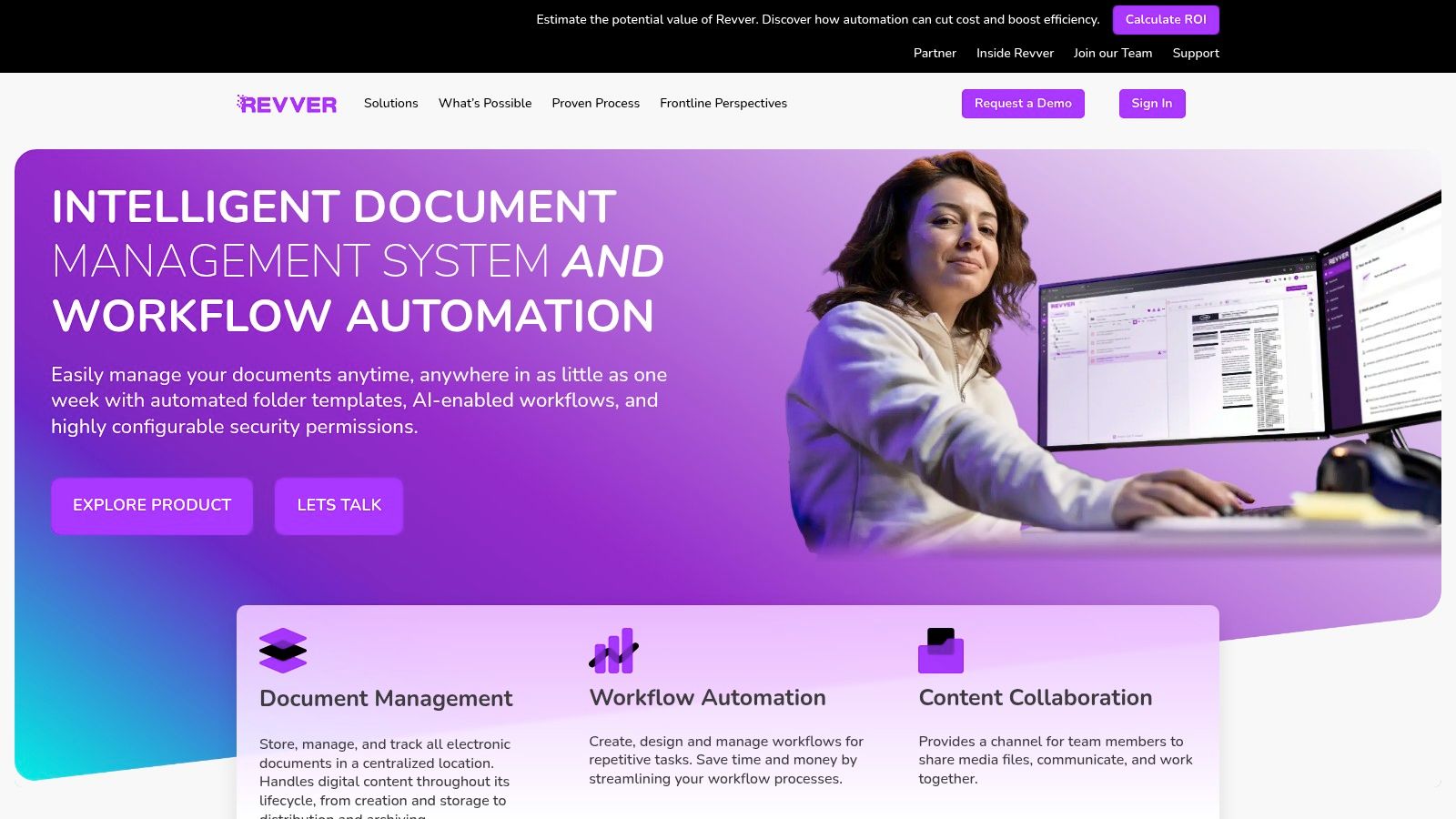
eFileCabinet shines in its ability to create secure, branded client portals, simplifying how businesses interact with their clients in a professional and organized manner. Imagine a law firm needing to securely share sensitive legal documents with clients. With eFileCabinet, they can create a dedicated portal, ensuring only authorized individuals have access. Similarly, a mortgage broker can use the platform to efficiently collect and manage loan applications and supporting documents, accelerating the loan approval process. This platform facilitates secure document exchange, improves client communication, and enhances overall efficiency.
One of eFileCabinet’s key strengths lies in its robust security features. The software employs advanced encryption and audit trails, ensuring compliance with industry regulations and safeguarding sensitive data. For industries like finance and healthcare, where data privacy is crucial, these features are invaluable. Automated document capture and filing systems further streamline workflows, minimizing manual data entry and reducing the risk of errors. This automation translates to significant time savings and improved accuracy, freeing up staff to focus on more strategic tasks. Imagine an HR department onboarding new employees. eFileCabinet automates the collection and organization of employee documents, simplifying the process and ensuring compliance.
eFileCabinet also offers mobile apps, allowing users to access and manage documents on the go. This feature is particularly useful for field workers or executives who need access to critical information anytime, anywhere. A real estate agent, for instance, can quickly access property documents during a showing, providing clients with immediate information. This mobile accessibility empowers businesses to stay connected and responsive, enhancing productivity and client satisfaction.
While eFileCabinet excels in security and document management, there are some areas to consider. Customization options for portal design are somewhat limited compared to some competitors. Additionally, more advanced features come at a higher price point. Pricing information isn’t readily available on the website, requiring potential users to contact sales for a quote. While eFileCabinet offers integrations, it may not be as extensive as some larger platforms. Finally, some users have reported occasional performance issues, though these appear to be isolated cases.
Practical Applications & Use Cases:
- Legal Firms: Securely manage client documents, share legal files, and automate workflows for case management.
- HR & Staffing Agencies: Streamline onboarding processes, collect employee documents, and maintain compliant records.
- Real Estate Agencies: Manage property documents, tenant applications, and facilitate secure communication with clients.
- Mortgage Brokers: Automate loan paperwork, securely collect client information, and expedite the loan approval process.
Implementation Tips:
- Plan your document structure: Before implementation, map out how you want to organize your documents within the system for optimal searchability and accessibility.
- Train your team: Provide comprehensive training to all users to ensure they understand the platform’s features and can utilize them effectively.
- Start with a pilot program: Begin by implementing eFileCabinet with a small group of users to test the system and identify any potential issues before a full rollout.
Despite some limitations, eFileCabinet offers a powerful and secure solution for document portal software needs, particularly for businesses prioritizing robust security, compliance, and efficient workflows. Its focus on professional services and user-friendly interface makes it a worthy contender in the market. For those seeking a purpose-built platform for secure document sharing and streamlined processes, eFileCabinet deserves serious consideration. Visit their website (https://www.efilecabinet.com/) for more information and to request a demo.
Document Portal Software Feature Comparison
| Platform | Core Features / Automation ✨ | Security & Compliance 🏆 | User Experience & Customization ★ | Target Audience 👥 | Pricing & Value 💰 |
|---|---|---|---|---|---|
| Superdocu 🏆 | Automated workflows, branded portals, validation dashboard ✨ | GDPR compliant, encryption, European hosting 🏆 | Intuitive UI, pre-built templates, white-label ✨ | SMBs to Enterprises 👥 | From €97/month, 7-day trial 💰 |
| SharePoint | Metadata libraries, MS365 integration, customizable workflows | Enterprise-grade security, granular permissions | Highly customizable, deep Microsoft ecosystem ★ | Enterprises & large organizations 👥 | Higher tier pricing 💰 |
| Box | External collaboration, workflow automation, custom branding | Strong security, DLP, watermarking | User-friendly, limited portal design customization | Businesses needing secure sharing 👥 | Premium pricing+ limits 💰 |
| Confluence | Wiki-style docs, real-time collaboration, Atlassian apps | Standard enterprise security | Great for knowledge bases, rich templates ★ | Teams & project groups 👥 | Mid-range pricing 💰 |
| Notion | Block editor, databases, real-time collaboration | Basic security, lacks advanced enterprise features | Highly flexible, easy to use ★ | Small teams, startups 👥 | Freemium + affordable plans 💰 |
| Drupal | Modular CMS, advanced permissions, custom workflows | Strong security, open-source | Fully customizable, steep learning curve | Developers & enterprises 👥 | Free core, hosting costs only 💰 |
| M-Files | AI classification, metadata-driven, workflow automation | Compliance-centric, audit trails | Powerful automation, less portal customization | Regulated industries 👥 | Higher cost, enterprise tier 💰 |
| eFileCabinet | Secure client portals, eSignature, automated filing | Encryption & audit trails | User-friendly, limited customization | Professional services firms 👥 | Premium pricing, fewer integrations💰 |
Ready to Transform Your Document Management?
Choosing the right document portal software can significantly impact your business, whether you’re a small business owner, a legal professional, or managing a large real estate portfolio. We’ve explored several top contenders, from established players like SharePoint and Box to versatile platforms like Notion and Confluence, and specialized solutions like M-Files and eFileCabinet, each offering unique features and capabilities. Remember to consider your specific needs when making a decision. Are you primarily focused on secure client document management like a legal firm, or perhaps streamlining candidate onboarding like an HR agency? Maybe efficient loan paperwork processing as a mortgage broker is your priority, or perhaps secure driver documentation for your transportation company? Even complex immigration documentation or the intricacies of portfolio management can be simplified with the right document portal software.
Key takeaways when selecting your ideal solution include scalability, security features, integration capabilities with existing systems, and of course, budget considerations. Efficient document management relies not only on a robust platform but also on optimizing the documents themselves. Document portal software helps streamline workflows and improve data management, but large files can hinder these benefits. Understanding the benefits of file compression from Compresto can greatly enhance the effectiveness of your chosen system. Implementing a new document portal requires careful planning and training to ensure smooth adoption across your team.
By carefully evaluating these factors and aligning them with the features offered by the tools discussed – including Drupal and Superdocu – you can empower your organization with a seamless and efficient document management system. Take the next step towards optimized workflows and enhanced productivity. Streamline your document collection and management with Superdocu, a powerful document portal software designed to meet the diverse needs of businesses like yours. Discover how Superdocu can transform your document processes and unlock new levels of efficiency.
